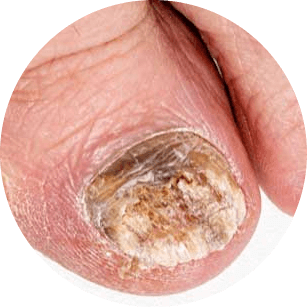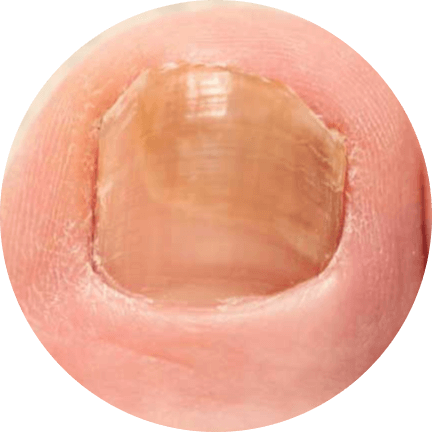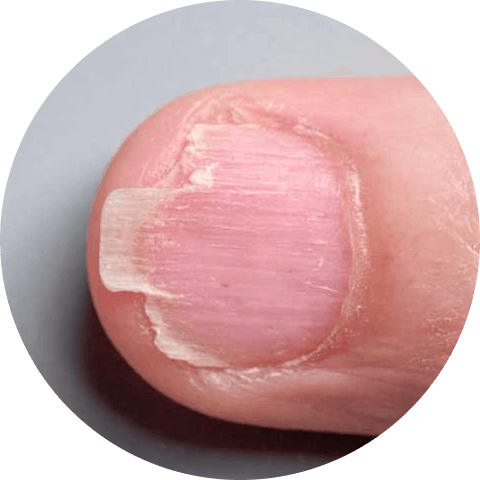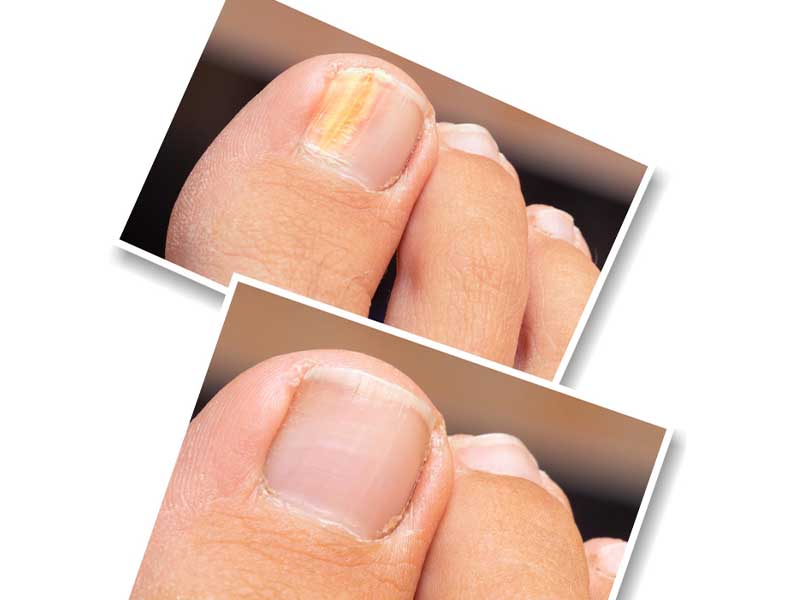Nail fungal infections, commonly known as nail fungus, are a common problem that affects millions of people worldwide. This condition can be caused by various factors, such as poor hygiene, injury to the nail, weak immune system, and exposure to moist environments. It can also affect people of all ages and genders, but it is more common in older adults.
In this ultimate guide, we will provide you with comprehensive information on nail fungus, including its causes, symptoms, diagnosis, and treatment options. We will also give you tips on how to prevent nail fungus from recurring and share some nail fungus pictures to help you identify the condition.
Nail Fungus Causes
Nail fungus is caused by various types of fungi, including dermatophytes, yeasts, and molds. These fungi thrive in warm, moist environments, making your nails an ideal breeding ground. Some of the most common causes of nail fungus include:
- Poor hygiene: If you don’t keep your nails clean and dry, you are at a higher risk of developing nail fungus. Fungi thrive in warm, moist environments, so it’s essential to keep your nails dry and clean at all times.
- Trauma to the nail: If you injure your nail, it can create an opening for fungi to enter and thrive. This is why athletes and people who wear tight shoes or high heels are at a higher risk of developing nail fungus.
- Weakened immune system: People with weakened immune systems, such as those with HIV/AIDS or diabetes, are more susceptible to developing nail fungus.
- Exposure to moist environments: Fungi thrive in moist environments, so if you spend a lot of time in wet areas like pools, showers, or locker rooms, you are at a higher risk of developing nail fungus.
- Family history: If your family has a history of nail fungus, you may be more prone to developing it yourself.

Nail Fungus Symptoms
The symptoms of nail fungus can vary depending on the severity of the infection. Here are some common signs to look out for:
- White or yellow spots under the nail
- Thickened, discolored, or distorted nail
- Foul odor coming from the affected nail
- Brittle nails that may separate from the nail bed
- Pain and discomfort around the affected nail
- Difficulty walking or wearing shoes if the infection spreads to the toenails
If you notice any of these symptoms, it’s essential to seek medical attention as soon as possible. Nail fungus is a common condition, but it can quickly progress if left untreated. Your doctor can diagnose the infection and recommend the best treatment plan for you. Discover the comprehensive nail diseases chart now and take the first step towards healthy nails!

There are several risk factors that can increase your chances of developing nail fungus. Here are some of the most common:
- Poor nail hygiene: Failing to keep your nails clean and dry can create an ideal environment for fungi to grow.
- Damaged nails: Injuries to the nail, such as a break or a crack, can make it easier for fungi to enter and infect the nail.
- Weakened immune system: Certain medical conditions or medications can weaken your immune system, making you more susceptible to infections like nail fungus.
- Age: Nail fungus is more common in older adults because nails become drier and more brittle with age, making them more susceptible to infection.
- Genetics: Some people may be more prone to developing nail fungus due to their genetic makeup.
Nail Fungus Diagnosis
If you suspect that you have nail fungus, it’s crucial to seek medical attention as soon as possible. While nail fungus may seem like a minor issue, it can quickly progress and cause serious damage to your nails if left untreated. In some cases, it may even spread to other parts of your body, such as your skin or lungs.
When you visit your doctor, they will examine the affected nail and may take a sample to send to a lab for testing. This sample will be used to identify the specific type of fungus that is causing the infection. Knowing the type of fungus is essential because different fungi respond to different treatments. By identifying the specific fungus, your doctor can prescribe the most effective treatment for you.
In some cases, a doctor may use a Wood’s lamp, which is a special type of ultraviolet light, to help diagnose the infection. This lamp can help reveal any fluorescence caused by certain types of fungi. However, this method is not always accurate, and a lab test is usually necessary for a definitive diagnosis.

It’s important to note that over-the-counter treatments may not be effective in treating nail fungus. If you suspect that you have nail fungus, it’s best to see a doctor to get a proper diagnosis and treatment plan. Your dermatologist may prescribe antifungal medication, which can be taken orally or applied topically.
If you have a severe case of nail fungus, your doctor may recommend surgical removal of the affected nail. This procedure is usually done under local anesthesia and involves removing the infected nail and applying an antifungal cream to the nail bed.
It’s essential to follow your dermatologist’s instructions carefully when treating nail fungus. Depending on the severity of the infection, it may take several months for your nail to completely heal. However, with proper treatment, you can get rid of nail fungus for good and restore the appearance of your nails.
Nail Fungus Treatment
There are several treatment options available for nail fungus, including:
- Antifungal medication: Your doctor may prescribe an oral or topical antifungal medication to help eliminate the infection. These medications work by killing the fungus or preventing it from spreading.
- Laser therapy: Laser therapy is a non-invasive treatment option that uses a laser to target and kill the fungus. This treatment is relatively painless and has a high success rate.
- Surgery: In severe cases, surgery may be necessary to remove the infected nail. This procedure is usually done under local anesthesia and has a high success rate.

Discover the remarkable ways a dermatologist can transform your nails with nail dermatology.
Preventing Nail Fungus
Preventing nail fungus is much easier than treating it. Here are some tips to help prevent nail fungal infections:
- Keep your feet clean and dry: Fungi thrive in moist environments. So, make sure to keep your feet clean and dry. Use mild soap to wash your feet and dry them thoroughly, especially between the toes.
- Wear breathable shoes: Shoes made of breathable materials such as leather or canvas allow air to circulate around your feet, keeping them cool and dry. Avoid wearing shoes made of synthetic materials, such as plastic or rubber.
- Avoid sharing personal items: Do not share your personal items such as socks, shoes, and nail clippers with others. Sharing these items can spread fungal infections.
- Use antifungal sprays or powders: If you are prone to fungal infections, use antifungal sprays or powders to prevent them. Apply these products to your feet and shoes regularly.
- Choose a reputable nail salon: Make sure the nail salon you choose follows proper hygiene practices. After each use, they should sterilize their instruments and avoid reusing nail files and other tools.

Final Thoughts
In conclusion, nail fungus is a common condition caused by various types of fungi, and it can affect people of all ages and genders. It can be treated with antifungal medication, laser therapy, or surgical removal of the affected nail. It’s crucial to seek medical attention as soon as possible if you suspect that you have nail fungus. Additionally, practicing good nail hygiene and avoiding moist environments can help prevent the condition from recurring.

You can also benefit from online dermatology consultation services such as Remotederm, which can provide them with easy and convenient access to expert dermatologists who can diagnose and treat their nail fungus remotely. Overall, with proper diagnosis and treatment, patients can get rid of nail fungus for good and restore the appearance of their nails.
FAQs
1. Can nail fungus spread to other parts of the body?
Yes, in some cases nail fungus can spread to other parts of the body, such as the skin or lungs. It’s important to seek medical attention if you suspect you have nail fungus to prevent the infection from spreading.
2. How long does it take to treat nail fungus?
The length of time it takes to treat nail fungus can vary depending on the severity of the infection and the type of treatment used. It can take several months for the infection to clear up completely, and it’s important to follow your doctor’s instructions carefully to ensure the best results.
3. Are there any natural remedies for nail fungus?
Some natural remedies for nail fungus include tea tree oil, vinegar, and garlic. However, it’s important to note that these remedies may not be as effective as prescription treatments, and they should not be used as a substitute for medical treatment.
4. Can nail fungus come back after treatment?
Yes, nail fungus can come back after treatment. To prevent a recurrence, it’s important to take steps to keep your nails clean and dry, avoid tight-fitting shoes or socks, and practice good hygiene habits. Your doctor may also recommend follow-up appointments to monitor your condition and ensure that the infection does not return.
5. Can I treat nail fungus with over-the-counter remedies?
Over-the-counter remedies like antifungal creams or nail polishes may help treat mild cases of nail fungus. However, for more severe cases, it’s important to see a doctor for a proper diagnosis and treatment plan.
